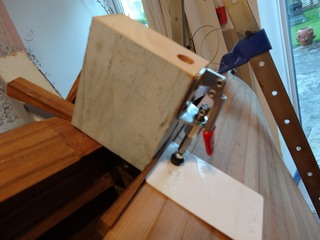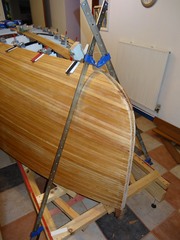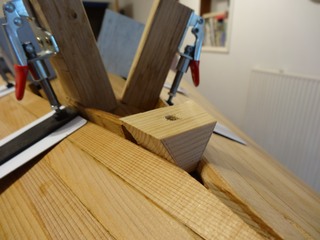





More on bow clamps
Clamping the strips to the bow effectively has been the biggest challenge so far. As the build progresses, the strips have to bend both across the width and the thickness as well as twist. A further problem is that my aluminium clamps become useless when they no longer fit between the next plank and the hog, so I have tried all sorts of methods, with varying degrees of success (or failure, depending on how much of a perfectionist you are). A couple of photos below show some of my attempts.



Clamps versus Nails / Staples
I am not really qualified to compare construction using clamps or nails as I have no experience of using the second “traditional” method. However, several things have become clear.
1) Clamping is NOT for the professional boat-builder, as it takes about 2 hours to set up the clamps, epoxy a pair of strips (one for each side of the boat), clamp them down and clean off the excess epoxy, and another four hours for the epoxy to harden sufficiently to be able to remove the clamps. However, if several boats of the same design were to be constructed, it should be possible to use the holes drilled for the holding nails for the first hull to be used for subsequent builds, thus eliminating the setting up time. The use of fast-setting waterproof PVA would reduce the waiting time between planks.
2) Clamping leaves a superb hull finish, with no nail or staple marks. Further, the wedges push the joints together between moulds, so there is no need for bungees, clips, tourniquets or any of the other numerous suggestions I have seen on the Internet for aligning the planks between the formers.








